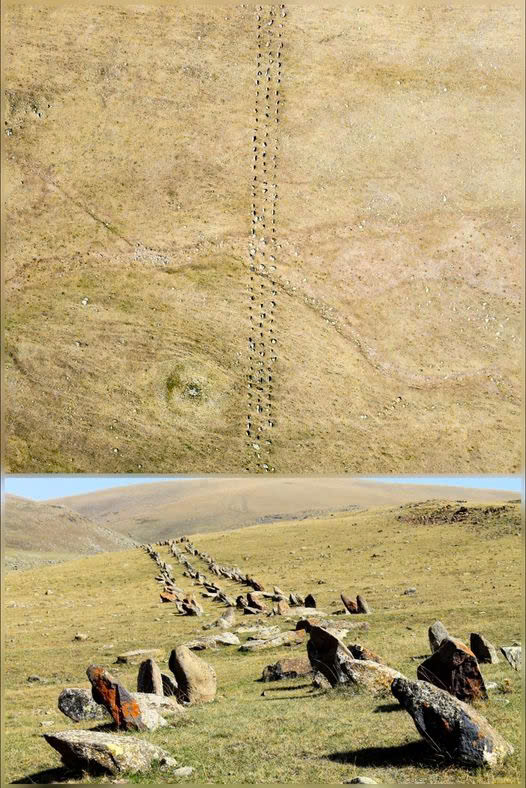Hidden deep within the rugged Armenian mountains lies a captivating archaeological marvel that remains largely unknown to the wider world — the Hartashen Megalithic Avenue. Estimated to be between 6,000 and 8,000 years old, this extraordinary site offers a glimpse into ancient human ingenuity and stands as a silent testament to the complexities of early civilization. Despite its significance, Hartashen continues to puzzle researchers and archaeologists, its true purpose still shrouded in mystery.

The story of Hartashen’s discovery begins in the 1970s, during the Soviet era. While surveying remote areas of Armenia, a group of Soviet archaeologists stumbled upon something remarkable — a sprawling collection of massive stone monoliths scattered across the landscape. Some of these towering stones reached heights of up to 20 feet (approximately 6 meters), immediately sparking interest among the archaeological community. As initial excavations began, researchers uncovered more than just the large standing stones. They found intricate stone platforms, pathways, and smaller arrangements of rocks that hinted at the sophistication of the people who built them.
What makes Hartashen particularly fascinating is the precision and craftsmanship of its granite monoliths. Despite their ancient origin, these stones have retained sharp edges and detailed carvings, suggesting they were intentionally shaped and placed. The alignment of these monoliths is not random — rather, they follow specific patterns and orientations that have led experts to develop a number of competing theories about the site’s original function.
One of the most widely discussed interpretations is that Hartashen may have functioned as a primitive astronomical observatory. The idea is based on the meticulous alignment of the stones, which some believe were designed to track celestial phenomena such as solstices, equinoxes, or the movement of particular stars. The ancient builders might have used the monoliths to monitor the changing sky, making Hartashen one of the earliest known attempts at understanding the cosmos.
However, not all researchers are convinced that astronomy was the primary purpose of the site. Another prominent theory suggests that Hartashen was a ceremonial avenue — a sacred space where rituals, gatherings, and spiritual ceremonies took place. Supporting this interpretation are the stone circles and secondary structures scattered throughout the area, which bear resemblance to known ritual sites from other ancient cultures. These components imply that Hartashen may have served as a spiritual or communal gathering place for early peoples, offering a space for worship and cultural exchange.
Adding to the mix of theories is a more practical hypothesis — that Hartashen may have been part of a major trading route or waystation. Its location near natural springs and freshwater sources would have made it an ideal stopping point for travelers and traders moving through the region. While this theory helps explain the site’s geographic placement, it doesn’t account for the intentional astronomical alignments or the massive scale and effort involved in its construction.
Despite the differences among these theories, what remains clear is the historical importance of Hartashen. The sheer size and complexity of the site point to a society with considerable technological skill and social organization — one that predates many of the world’s better-known ancient civilizations. The ability to transport, carve, and erect such large stones suggests an advanced understanding of engineering and physics, as well as a cultural or spiritual drive that compelled its creators to build something enduring.
Hartashen’s significance goes beyond its contribution to academic research. It represents an untapped resource for Armenia’s cultural tourism. Unlike other ancient sites that have been heavily commercialized, Hartashen remains relatively untouched, offering visitors a raw and authentic experience. Tourists seeking unique adventures and a deeper connection with human history could find Hartashen an irresistible destination. With proper preservation efforts and sustainable tourism initiatives, the site could become a beacon for heritage travelers while also contributing to local economic development.
Unfortunately, much about Hartashen remains unknown. Political unrest and instability following the collapse of the Soviet Union disrupted early research efforts, leaving large parts of the site unexamined and many questions unanswered. Decades later, renewed interest in the site has reignited scientific curiosity, but significant funding and international collaboration are still needed to unlock its full potential.
What makes Hartashen even more captivating is its enduring mystery. It stands not just as a collection of stones but as a cultural puzzle, a lingering question from humanity’s distant past. Each stone, each alignment, each carved symbol invites speculation and study, urging researchers to piece together the story behind it. Was this a temple to the stars, a marketplace for ancient goods, or a sacred road walked by generations past? The answers may still lie beneath the surface, waiting for future archaeologists to uncover.
Until then, the Hartashen Megalithic Avenue remains one of Armenia’s most enigmatic and awe-inspiring archaeological treasures. It challenges our understanding of what ancient people were capable of and reminds us that the roots of human civilization run deeper and more mysteriously than we often realize. As science advances and interest grows, perhaps this ancient site will finally yield its secrets, offering us a clearer view of how early societies saw their world, understood the universe, and built lasting monuments to their beliefs and knowledge.
In the meantime, Hartashen continues to stand — enduring through centuries of silence, untouched by time, and waiting to share its story with those who dare to listen.





